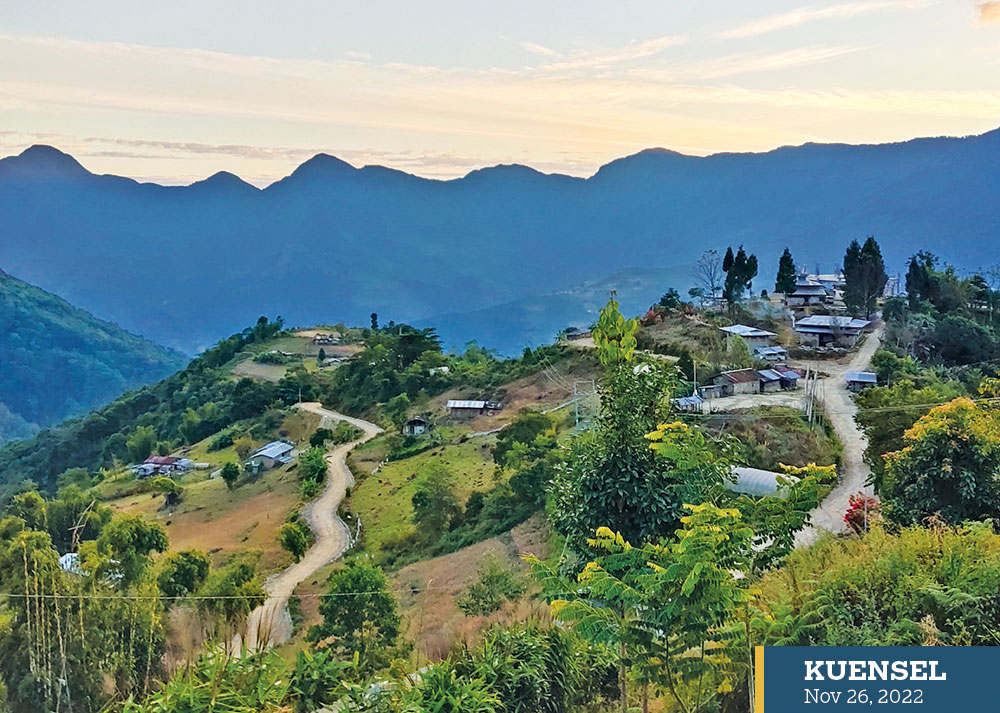Choki Wangmo | Shingkhar Lauri
My job, as a reporter, takes me to new and exciting places. However, I do more than take in the blessings of the opportunities. My job requires me to look and see beyond what is plain and natural.
Not this time. I abandoned my “reporter’s lens” and headed out straight just to explore. This is when I truly realised how biased we can be.
It was already dark when we entered Bhutan Gate after a day of gruelling journey through the warm plains of Assam in India. I was told that we’d arrived at Jomotsangkha. In a dead town, I just saw some flickering lights.
It takes one day to travel from Phuentsholing to Jomotsangkha; two day’s journey via the east-west highway.
It was already past nine at night when we had our dinner at a community monastery. We were following a young trulku who was returning to his old monastery in Shingkhar Lauri from Paro.
Early morning, the sunrise had a sub-tropical tinge. I could hear the calls of myna birds. There was renewed energy among the travellers. Most of them were visiting their homes after decades. Attraction of towns had drawn many young people away from the villages.
By eight in the morning, we were on the road again. The road to Shingkhar Lauri begins from Langchenphu. The semi-urban gewog has a central school and is a centre of activities in the area.
After Langchenphu, it is an arduous climb through the dusty, winding roads, and steep slopes. These roads are not for amateur drivers or flashy cars.
“We remain cut off most of the time. It becomes difficult for pickup trucks and SUVs during monsoon. Landslides kill people,” said a villager with nonchalance.
I learnt that Shingkhar Lauri is not a single village. Three gewogs—Langchenphu, Serthi, and Lauri in Samdrupjongkhar and Shingkhar in Merak in Tashigang collectively make up Shingkhar Lauri.
Phaju Gonpa in Lauri gewog shares border with Merak in Tashigang. It is said that most of the residents from Phaju Gonpa moved to lower parts of Lauri, Serthi, and Langchenphu.
I stayed most of my journey at Phagchok in Serthi gewog. The place is located on a hilltop and has a picturesque view over other valleys. During three days of celebration, I got to observe the varied cultures—Ache Lhamo dance, especially.
I realised that although we are accustomed to separate nature and human perception into two realms, they are, in fact, indivisible. “Landscape is the work of the mind. Its scenery is built as much from strata of memory as from layers of work,” said some wise person.
Here, people wake up before the early calls of the Blue-whistling Thrush. Men here wear white and grow long hair. Women ensure that everyone is provided for during retreats.
Peling and Dudjom Tersar traditions are widely practiced in the region.
They grow sweet buckwheat, maize, and other grains. Bokpi, dough made from maize or buckwheat flour, is a special cuisine. It is served with steamed radish leaves or spinach.
Shingkhar Lauri is located in the mountains that are the citadels of local deities—Aum Jomo, her daughter Ani Uni, and her warrior, Drekpa Wangdi, whom residents call Memey.
Tshen-chen Drekpa Wangdi is the kelha (birth deity) for people born in the region.
Even the name Jomotsangkha is derived from the legends of Ama Jomo. Jomri, a river that flows below the villages is named after Ama Jomo.
Here, I found near-total contentment. But it is an unfair statement; young people in this region have realised it. There are visible signs of rapid rural-urban migration.
The wind of change is blowing; Bhutanese villages are changing, fast.


